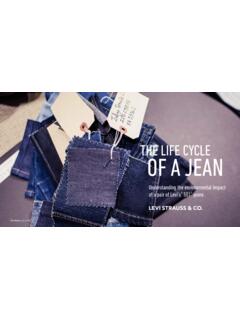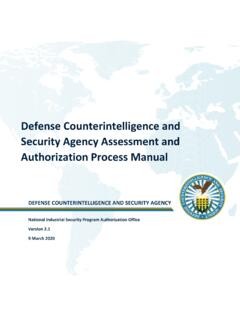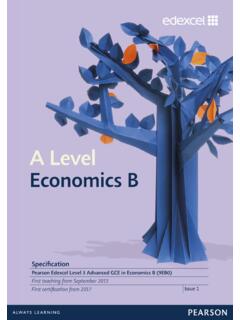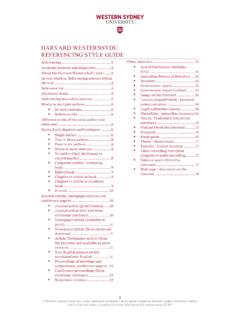Transcription of Reflection paper on statistical methodology for the ...
1 Official address Domenico Scarlattilaan 6 1083 HS Amsterdam The Netherlands An agency of the European Union Address for visits and deliveries Refer to Send us a question Go to Telephone +31 (0)88 781 6000 European Medicines Agency, 2021. Reproduction is authorised provided the source is acknowledged. 26 July 2021 EMA/CHMP/138502/2017 Committee for Medicinal Products for Human Use (CHMP) Reflection paper on statistical methodology for the comparative assessment of quality attributes in drug development Draft agreed by Biostatistics Working Party Fe bruary 2017 Adopted by CHMP for release for consultation 23 March 2017 Start of public consultation 01 April 2017 End of consultation (deadline for comments) 31 March 2018 Agreed by Biostatistics Working Party June 2021 Adopted by CHMP 22 Ju ly 2021 Keywords statistical methodology , comparative assessment , quality attributes, drug development, manufacturing changes, biosimilars, generics, dissolution, inferential statistical methods, similarity assessment Reflection paper on statistical methodology for the comparative assessment of quality attributes in drug development EMA/CHMP/138502/2017 Page 2/21 Table of contents executive summary .
2 3 1. Introduction .. 3 2. Legal basis and relevant guidelines .. 4 3. Definitions and working assumptions .. 5 4. Approaching the quality attributes comparison task from the inferential statistical perspective .. 7 Understanding a manufacturing process as a data distribution .. 7 Similarity condition .. 8 Using a similarity criterion to investigate if the pre-determined similarity condition holds for a single QA .. 9 Sampling / Experimental Approach .. 10 Revisiting frequently applied similarity criteria .. 11 Selecting a similarity criterion from a range of possible candidates .. 13 Overall conclusion of similarity at the quality level .. 14 5. Implications for settings where the comparison on the quality level is of particular relevance in regulatory decision-making .. 15 Biologicals .. 15 General issues relating to Comparability exercises .. 15 Specific issues relating to manufacturing changes.
3 17 Specific issues for Biosimilar setting .. 18 Small molecules .. 19 Specific issues for abridged/hybrid applications .. 19 6. Quality Attributes data comparison protocol .. 20 Reflection paper on statistical methodology for the comparative assessment of quality attributes in drug development EMA/CHMP/138502/2017 Page 3/21 executive summary This Reflection paper identifies specific areas where the quantitative comparative evaluation of drug product quality characteristics plays an important role from the regulatory perspective. This might involve decision making processes potentially leading to marketing authorisation as well as post-authorisation decisions during drug lifecycle. The document focusses on methodological aspects in relation to statistical data comparison approaches for pre- and post-manufacturing changes, biosimilar development, and generics development. The Reflection paper raises open issues from a statistical perspective, and addresses questions related to comparison objectives, sampling strategies, sources of variability and options (or limitations) for statistical inference.
4 This document is targeted at both experts from industry and regulatory assessors. This Reflection paper complements other available regulatory guidance where comparative data assessment of quality attributes is discussed for certain contexts, but also provides more detailed guidance of how to actually carry out the comparison task based on empirical sample data. From the methodological perspective, the Reflection paper aims to establish a common language and to improve understanding among all experts concerned with quality characteristics data comparison. It is also intended to trigger further discussion of realistic requirements to demonstrate similarity at the quality level in the different contexts mentioned above. The Reflection paper also discusses likely limitations hampering statistical inference, pointing towards meaningful, but expectedly less stringent, alternatives. 1.
5 Introduction The comparison of empirical data from quality characteristics of drug products (Quality Attributes, QA) is of importance in many areas of drug development. One common objective of such comparative data analyses is to demonstrate that two drug products (or drug substances) stemming from two different manufacturing processes are similar with regard to relevant QAs. Many of these comparisons are carried out during early drug development, prior to the initiation of clinical trials. The outcome of such comparative investigations has an impact on decisions concerning subsequent development steps. In this early development setting, the adequacy of the (similarity) conclusions drawn from comparative analyses of QAs primarily relates to the producer s risk. Measures to control this risk are in the remit of the drug developer, and are hence not in the focus of regulation. However, there are also many comparison settings involving comparative QA data analysis with the aim to demonstrate similarity, which have a direct (or sometimes even pivotal) impact on regulatory decision making.
6 This Reflection paper is intended to raise awareness that in these cases adequate control of the risk for a false positive similarity decision is crucial. From a regulatory decision making perspective, it is the regulator s responsibility to understand the comparison approaches that are applied, in order to adequately inform the decisions for approval, variation, and life cycle management of medicinal products. Examples, where the comparative evaluation of quality characteristics plays a major role in regulatory decision making are: the comparison of a particular drug product in versions pre- and post-manufacturing change, when it becomes necessary to establish a bridge between clinical trials, where the two versions of the drug product were used exclusively, Reflection paper on statistical methodology for the comparative assessment of quality attributes in drug development EMA/CHMP/138502/2017 Page 4/21 the comparison of a candidate biosimilar product to a reference medicinal product at the quality level, in particular in development programmes with (suggested) abbreviated clinical development parts, the comparison of a candidate generic product to the reference medicinal product, when a clinical (bioequivalence) trial is waived, and pivotal evidence to support similarity comes from comparative dissolution experiments.
7 In situations where pivotal evidence for similarity comes from comparative statistical analyses of clinical data, there is an established methodological framework in place, based on drawing inferences from samples (patients or healthy subjects). This involves agreed methods to justify equivalence limits for the variables of interest and statistical equivalence testing. Within the clinical data analysis framework, for each specific similarity criterion the (prospective) estimation of the risks to draw a false positive or a false negative decision is common practice. Once those risks are quantified, they serve as operating characteristics (OC) for the similarity criterion specified. OCs are usually used to assist in the choice of the most suitable statistical criterion ( statistical test) to demonstrate similarity. However, in situations exemplified above, where decision making primarily relies on comparisons other than clinical data ( analyses of QA data or in-vitro experimental data), regulatory decision making is currently often driven by heuristic approaches.
8 In general, following such approaches precludes the estimation of risks to draw false decisions, the determination of OCs is precluded as well. This fact currently hampers exploitation of the potential of QAs data comparisons to serve as a solid basis to draw similarity conclusions. It has to be acknowledged that the inferential analysis approach applied to clinical data cannot be easily transferred to quality data comparison. Distinct differences exist between the two settings in the nature of the data-generating processes, as well as in the options to control for important factors influencing the data of interest. Despite these differences, which will be addressed in more detail in subsequent sections, the goal of this paper is to reflect under which circumstances, and to what extent, the implementation of inferential statistical methodology can assist or even facilitate comparative evaluation of QA data.
9 Following a problem description, a two-step approach is introduced: firstly, consideration needs to be given to what would constitute an agreeable similarity condition based on assumed underlying data distributions; subsequently, a suitable similarity criterion needs to be identified and chosen to assess whether the similarity condition t ruly holds. This choice needs to be informed by exploration of OCs. After the definition of the legal basis in Section 2, Section 3 touches upon two related topics of comparative QA data analysis, critically assessment and manufacturing process control methodology . Section 4 presents important fundamental methodological prerequisites which need to be considered when establishing a statistical framework for decision making based on QAs data comparisons. Section 5 discusses the options as well as the possible limitations related to the use of inferential statistical methods in the context of various analysis settings, which would typically result from comparison tasks as exemplified above.
10 Section 6 provides guidance on how the various methodological aspects discussed can be reflected in prospective planning, and discusses the advantages of the preparation of a QA data comparison protocol . 2. Legal basis and relevant guidelines The legal basis and the procedures for making an application for a marketi ng authorisation are set out in Directive 2001/83/EC as amended and in Regulation (EC) No 726/2004. For generic applications the legal basis can be found in Article 6 of Regulation (EC) No 726/2004 and Article 10 of Directive 2001/83/EC as amended. The legal basis for similar biological medicinal products, also known as Reflection paper on statistical methodology for the comparative assessment of quality attributes in drug development EMA/CHMP/138502/2017 Page 5/21 biosimilars, can be found in Article 6 of Regulation (EC) No 726/2004 and Article 10(4) of Directive 2001/83/EC as amended.














